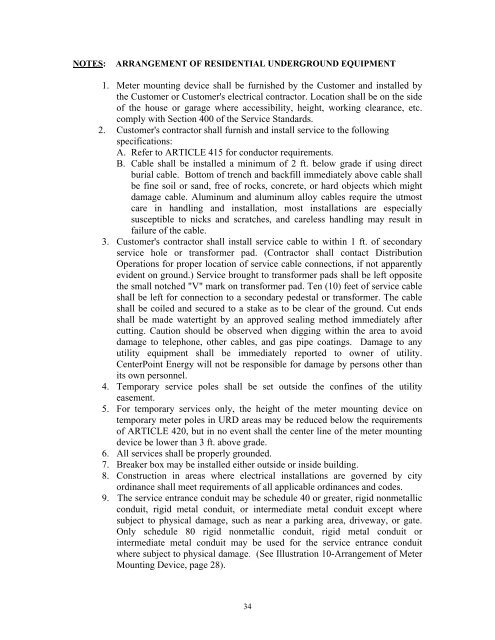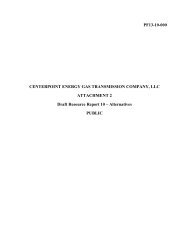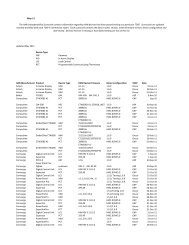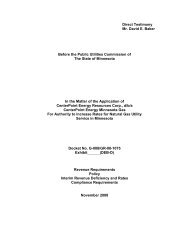Electric Service Standards - CenterPoint Energy
Electric Service Standards - CenterPoint Energy
Electric Service Standards - CenterPoint Energy
Create successful ePaper yourself
Turn your PDF publications into a flip-book with our unique Google optimized e-Paper software.
NOTES: ARRANGEMENT OF RESIDENTIAL UNDERGROUND EQUIPMENT<br />
1. Meter mounting device shall be furnished by the Customer and installed by<br />
the Customer or Customer's electrical contractor. Location shall be on the side<br />
of the house or garage where accessibility, height, working clearance, etc.<br />
comply with Section 400 of the <strong>Service</strong> <strong>Standards</strong>.<br />
2. Customer's contractor shall furnish and install service to the following<br />
specifications:<br />
A. Refer to ARTICLE 415 for conductor requirements.<br />
B. Cable shall be installed a minimum of 2 ft. below grade if using direct<br />
burial cable. Bottom of trench and backfill immediately above cable shall<br />
be fine soil or sand, free of rocks, concrete, or hard objects which might<br />
damage cable. Aluminum and aluminum alloy cables require the utmost<br />
care in handling and installation, most installations are especially<br />
susceptible to nicks and scratches, and careless handling may result in<br />
failure of the cable.<br />
3. Customer's contractor shall install service cable to within 1 ft. of secondary<br />
service hole or transformer pad. (Contractor shall contact Distribution<br />
Operations for proper location of service cable connections, if not apparently<br />
evident on ground.) <strong>Service</strong> brought to transformer pads shall be left opposite<br />
the small notched "V" mark on transformer pad. Ten (10) feet of service cable<br />
shall be left for connection to a secondary pedestal or transformer. The cable<br />
shall be coiled and secured to a stake as to be clear of the ground. Cut ends<br />
shall be made watertight by an approved sealing method immediately after<br />
cutting. Caution should be observed when digging within the area to avoid<br />
damage to telephone, other cables, and gas pipe coatings. Damage to any<br />
utility equipment shall be immediately reported to owner of utility.<br />
<strong>CenterPoint</strong> <strong>Energy</strong> will not be responsible for damage by persons other than<br />
its own personnel.<br />
4. Temporary service poles shall be set outside the confines of the utility<br />
easement.<br />
5. For temporary services only, the height of the meter mounting device on<br />
temporary meter poles in URD areas may be reduced below the requirements<br />
of ARTICLE 420, but in no event shall the center line of the meter mounting<br />
device be lower than 3 ft. above grade.<br />
6. All services shall be properly grounded.<br />
7. Breaker box may be installed either outside or inside building.<br />
8. Construction in areas where electrical installations are governed by city<br />
ordinance shall meet requirements of all applicable ordinances and codes.<br />
9. The service entrance conduit may be schedule 40 or greater, rigid nonmetallic<br />
conduit, rigid metal conduit, or intermediate metal conduit except where<br />
subject to physical damage, such as near a parking area, driveway, or gate.<br />
Only schedule 80 rigid nonmetallic conduit, rigid metal conduit or<br />
intermediate metal conduit may be used for the service entrance conduit<br />
where subject to physical damage. (See Illustration 10-Arrangement of Meter<br />
Mounting Device, page 28).<br />
34






